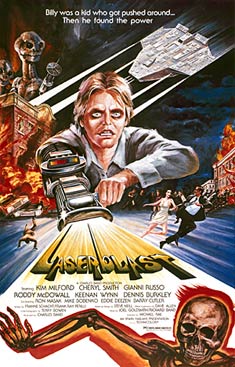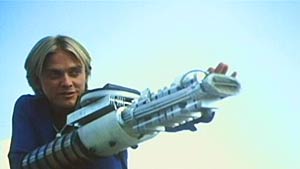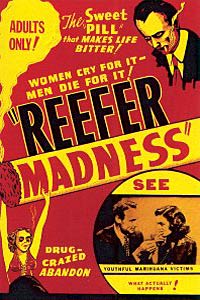Laser Madness
 I’m not much of a film critic.
I’m not much of a film critic.
I can admit it. The reason I can admit it is that I know I just don’t have the heart to slam a movie just because it’s a bad movie.
For me, “bad” is not enough of a qualifier to unleash on a film. Picking on a bad movie is like kicking a guy when he’s down. They’ve suffered enough. I’d rather save the sarcasm for the movies (and filmmakers) who are wildly successful. They can take it.
Having tried my hand at screenwriting (and having no luck at it), I learned to respect the process. I’ve been there. The shameless hawking of a story idea to anyone who’d listen. The rewrites of rewrites. Query letters. Trying to get an agent. Plowing through screenwriting books. All that.
If nothing else, the experience taught me that if a person actually does get a story turned into a movie, that’s really something. It’s a lot of work, and you really have to care strongly about what you’re doing if you even want a shot at seeing it through.
To sell a screenplay is a big deal. To see it then turned into a movie is a huge deal.
I firmly believe no one ever sets out to write a bad movie.
Because of this, I give “bad” movies slack. I try to look beyond their faults and weigh what their creators were trying to do or say.
All this is lead up for today’s review of what has been universally reviled as one of the worst movies of all time. The 1978 science fiction opus known as Laserblast.
For those of you unfamiliar with the film, it relates the tale of Billy, whom we are to understand is a much put-upon teenager, and the aftermath of his discovery of an extraterrestrial weapon of mass destruction. We follow Billy as he goes on a rampage against those who torment him, before finally descending into madness, mutation and eventual death at the hands of the aliens who return to Earth to reclaim the weapon.
Having watched it last night, my head is still awash in its non sequitur narrative and undisciplined editing. Admittedly, the movie almost begs to be mocked. The dialogue. The acting. The effects, which fail one of the fundamental rules of science fiction cinema, a little something I call “The Krofft Rule.”
Essentially the rule states that your special effects m ust be measurably better than something that Sid and Marty Krofft manufactured during their TV entertainment heyday. If you’re rolling out a full-fledged film and you can’t outshine the Krofts’ “Grumpy the Tyrannosaurus,” you’re in big trouble.
ust be measurably better than something that Sid and Marty Krofft manufactured during their TV entertainment heyday. If you’re rolling out a full-fledged film and you can’t outshine the Krofts’ “Grumpy the Tyrannosaurus,” you’re in big trouble.
I knew Grumpy. Grumpy was a friend of mine. And Laserblast, you’re no Grumpy.
Laserblast featured (“starred” is too strong a word choice) Kim Milford as Billy. For you Jeff Beck freaks out there, Kim sang lead vocals for the Jeff Beck Group for roughly two weeks during the summer of 1972. (You would have to be a pathological Jeff Beck fan to know that, which I’m not.)
Milford would find more rewarding work as the villain opposite Mark Hamill (aka Luke Skywalker) in one of cinema’s greatest triumphs of the late 1970s.
I’m talking, of course, about Corvette Summer.
Anyway, in Laserblast we follow Milford as he becomes a deranged mutant killer blasting cars, people and domiciles with the laser weapon that happenstance has placed in his care.
Rather than get hung up on its shortcomings, I spent some time reflecting on Laserblast and the message that its filmmakers might have been trying to tell us.
I think I’ve found something.
Laserblast is noteworthy in its nihilism in that the hero is also the villain. There is no real foil to Billy, until the very end when the aliens blast the rampaging youth in an act of supernatural justice.
As an audience, we are confused as to who we’re supposed to root for. Rather, we watch helplessly as our hero self-destructs. The fact that we don’t really care because the film is so bad is beside the point. This led me to surmise that Laserblast is actually a sort of cautionary tale. If it’s a cautionary tale, what are we being cautioned against?
Laserblast is the Reefer Madness of the space era.
Eureka! Of course. The parallels are obvious.
In Reefer Madness, troubled youth of the 1930s taste forbidden fruits, go insane and dead end in a fatal crime spree.
In Laserblast, troubled youth of the 1970s taste forbidden fruits, go insane and dead end in a fatal crime spree.
Looking at Laserblast from this angle, you can deduce deeper meanings behind the deaths of Billy’s victims. Also telling is who among the film’s cast survives Billy’s rampage.
In essence, almost no figure with real authority dies in the film. Not Billy’s absentee mother, who makes a brief cameo before jetting off to Acapulco. Not the mysterious government agent. Not Billy’s girlfriend’s grandfather, the Colonel. Not the hapless town sheriff.
The deaths are relegated to the two bumpkin deputies, two bullies (the most unlikely bullies you will ever meet – remember Mandark from Dexter’s Laboratory?), and Roddy McDowell.
(McDowell, who plays a doctor in the film and hence an authority figure, wasn’t supposed to die in the original script, but he begged to be off’d after he realized what the film was going to do to his career.)
So, no one of significant authority is killed. And in fact, it’s telling that the two bumpkin deputies are seen smoking a doobie early in the film, a precursor to later onscreen fatality if ever there was one.
Like Reefer Madness, Laserblast was intentionally mad e to demonstrate the inherent dangers of a forbidden fruit and to scare kids away from it.
e to demonstrate the inherent dangers of a forbidden fruit and to scare kids away from it.
In Laserblast’s case, that forbidden fruit was alien technology.
What it all boils down to is this. A government plot to keep us from using alien weapons of mass destruction.
Think I’m kidding?
Listen, in the late 70s we were still getting our outer space on. Shuttles, Voyager satellites, stuff like that. Who knew what kind of stuff we’d shake lose from the stars. You poke a finger at the stars, they might poke back.
Remember the times in which Laserblast was made. The year before, Richard Dreyfuss was making mashed potato sculptures and getting unexplained suntans.
The government had to hedge their bets. They had to spread the word.
If you find something that looks outer-spacey, don’t touch it! You could end up like Billy!
That’s right. Laserblast was a government propaganda film. How else could it have been so bad?



















 Full Details
Full Details



No comments yet.
Sorry, the comment form is closed at this time.